Fall 2016
Cable Broadband Technology Gigabit Evolution
Broadband Internet access has become an indispensable communications platform. Cable technology is enabling today’s broadband networks, and continues to push communications innovation toward the gigabit era.
Executive Summary
The Internet is the great enabler of contemporary communications. High-speed Internet access, or broadband, is a robust and growing platform that has widespread benefit to society and modern economies.
Broadband provided over cable networks, which utilize a mix of coaxial cable and optical fiber, is widely available, highly capable, and developed with private capital.
The most widely deployed generation of cable broadband, known as DOCSIS® 3.0, is designed for gigabit per second speeds. The latest cable technology, known as DOCSIS 3.1, is being commercialized now at a historically rapid pace and can provide up to 10 gigabits per second.
The top-line performance of cable broadband is well in excess of the requirements of today’s online applications. It has become a catalyst for a broad range of innovation, and the foundation for the delivery of next-generation services. It also allows cable operators to stay ahead of customer demand for broadband connectivity and to balance capacity across other network services such as television.
Cable is gigabit-ready today, and will continue to evolve to even higher performance in the future. Another generation of broadband technology is being incubated at CableLabs, which is designed to offer symmetric multi-gigabit speeds. Known as DOCSIS® 4.0, this technology will significantly increase the upstream capabilities of cable to support next-generation interactive broadband experiences.
Internet: An Indispensable Connectivity Tool
High-performing Internet connectivity, or broadband, is becoming ever more important to society, providing the foundation of modern economies and human interaction.
2 hrs, 51 mins
Average time spent online per person per day (IAB/UKOM/comScore)
Internet users now spend nearly three hours per day online, an average that has tripled in the past decade. Digital media use has tripled just since 2010. 75% of respondents to a recent Harris poll said that having daily access to Wi-Fi is important, and Google services now reach 95% of US Internet users each month. These are just a few guideposts to the intuitive conclusion that online connectivity is now central to daily life.
A range of economic research, from McKinsey to the ITU, has shown that the benefits of broadband underpin a large segment of nations’ gross domestic product, employment, and consumer surplus. Growth is aided by broadband through the adoption of efficient business processes, the introduction of new online services, and the investment and labor directly involved in the deployment and operation of networks. Economic dynamism is enhanced as new firms gain access to global markets at low cost. And consumers benefit through increased choice and lower costs for goods and services.
3.4 billion
Internet users around the world. (Internet Live Stats)
There are also non-economic benefits of broadband: Access to information enables a more engaged body politic, new forms of expression for individuals, and human connection that can occur across vast geographies in real-time.
Reflecting this widespread benefit, Internet usage continues to grow. The number of Internet users around the world now tops 3.4 billion, according to Internet Live Stats, and is expanding much faster than global population.
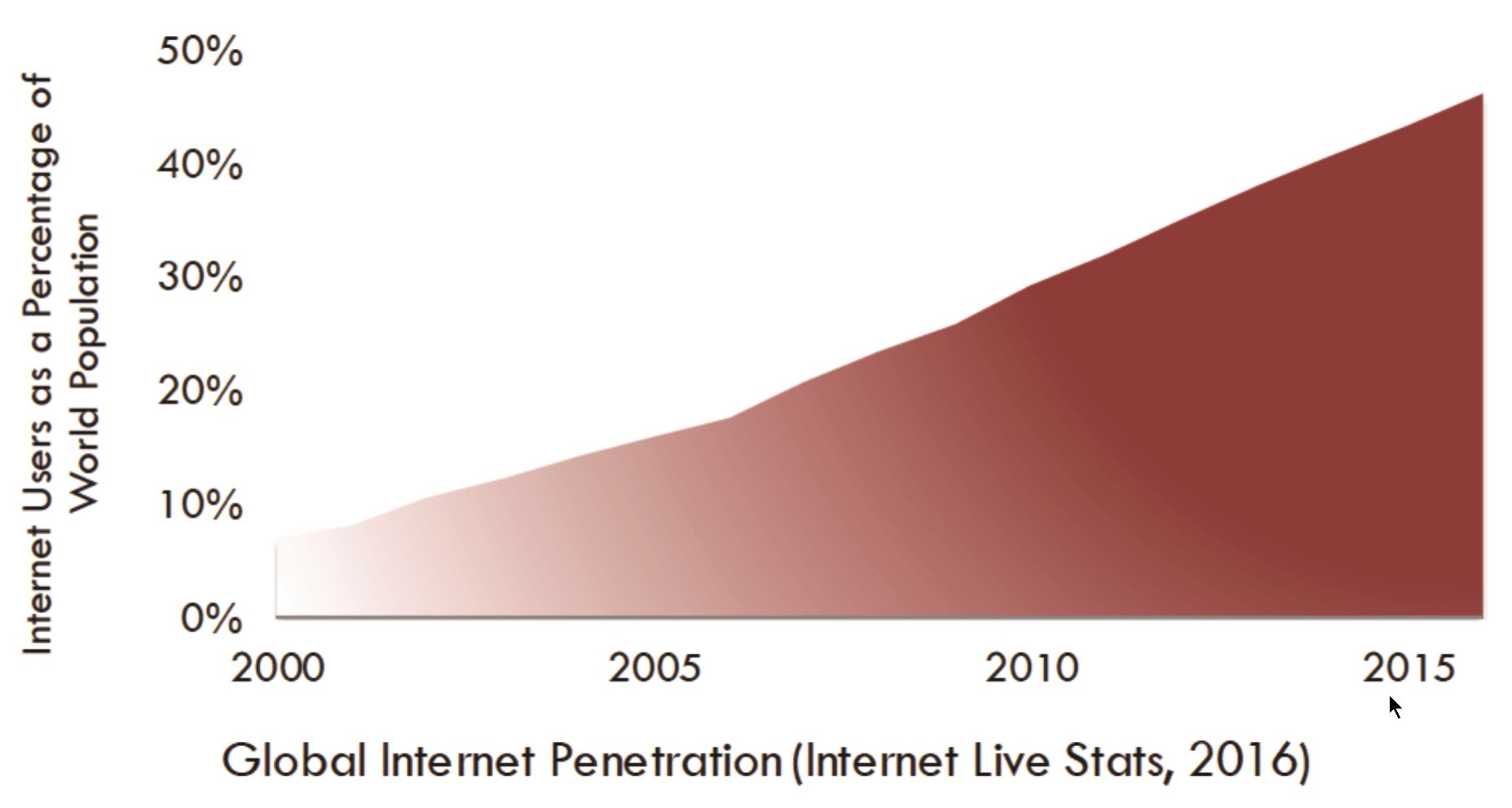
This growth is likely to continue and broadband networks will see increasing usage. Cisco forecasts that consumer Internet traffic will more than triple over the next five years.
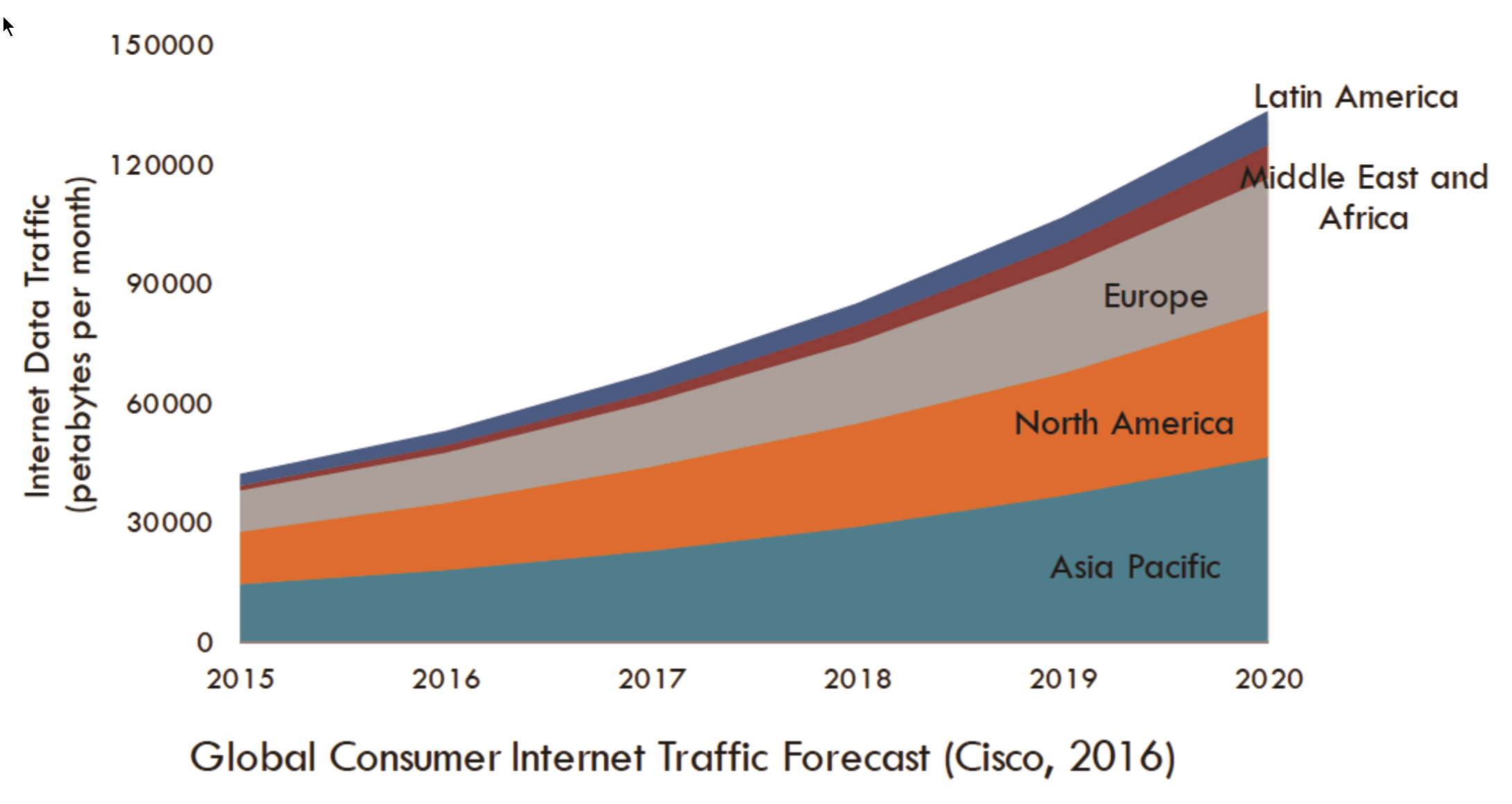
In short, broadband has become a transformative force that will continue to shape communications and society. Enabling this impact are the networks that make broadband Internet access possible.
Cable Broadband Network Deployment
Cable operators have deployed vast broadband networks across the globe.
In the United States, cable broadband now passes 93% of homes, far more than the coverage offered by high bitrate digital subscriber line (VDSL) technology and fiber-to-the-premise (FTTP). This widespread deployment has been spurred through communications policy that encourages investment in networks.
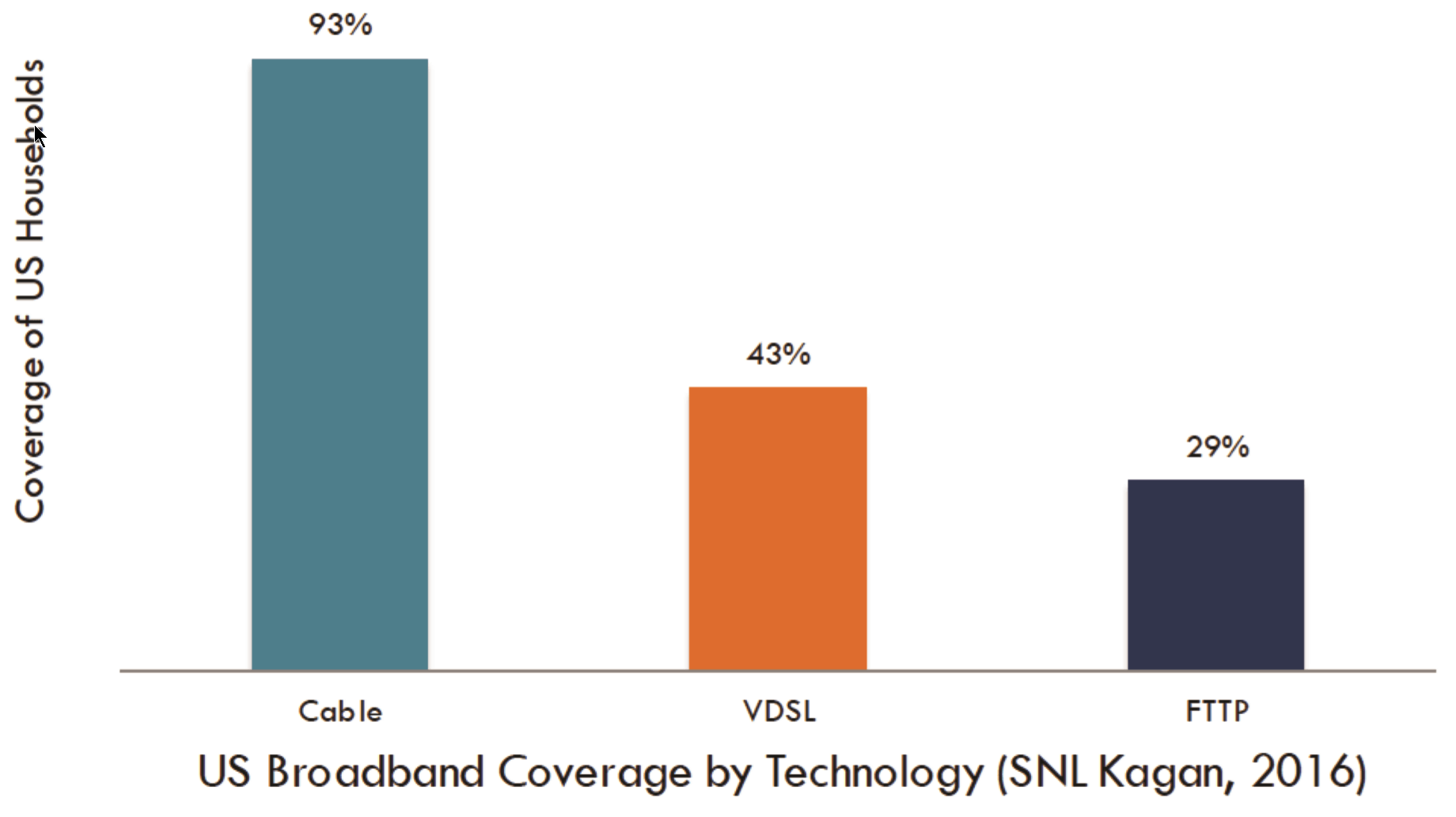
In contrast to the historic US emphasis on facilities-based competition, European government policies have traditionally emphasized service-based competition through wholesale access mandates on owners of network facilities. Research from the University of Pennsylvania has shown that the European policy approach has had a negative impact on broadband coverage. This is apparent in the slower deployment of cable broadband networks in Europe, relative to the US. Nevertheless, across all next-generation access technologies, cable networks today cover nearly half of the European Union, slightly exceeding VDSL, and greatly outpacing FTTP.
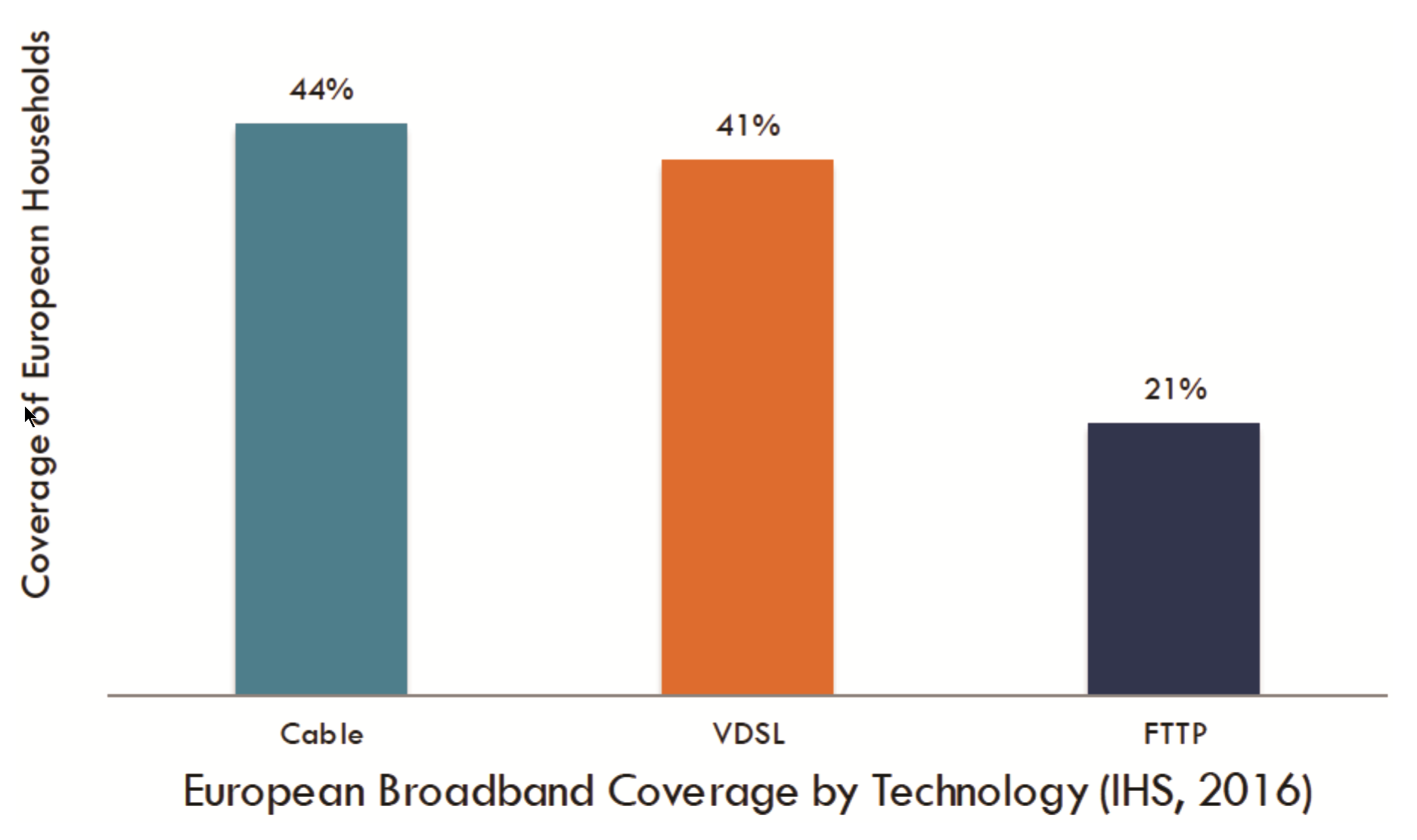
The appeal of cable broadband is reflected in subscribership to the service. During the period of 2009-2014 for which data is available, cable broadband saw greater subscriber growth than DSL and Fiber technologies in North America and Western Europe. (There are indications that FTTP subscribership has increased in the past two years in Europe, through global gains are driven largely by China.)
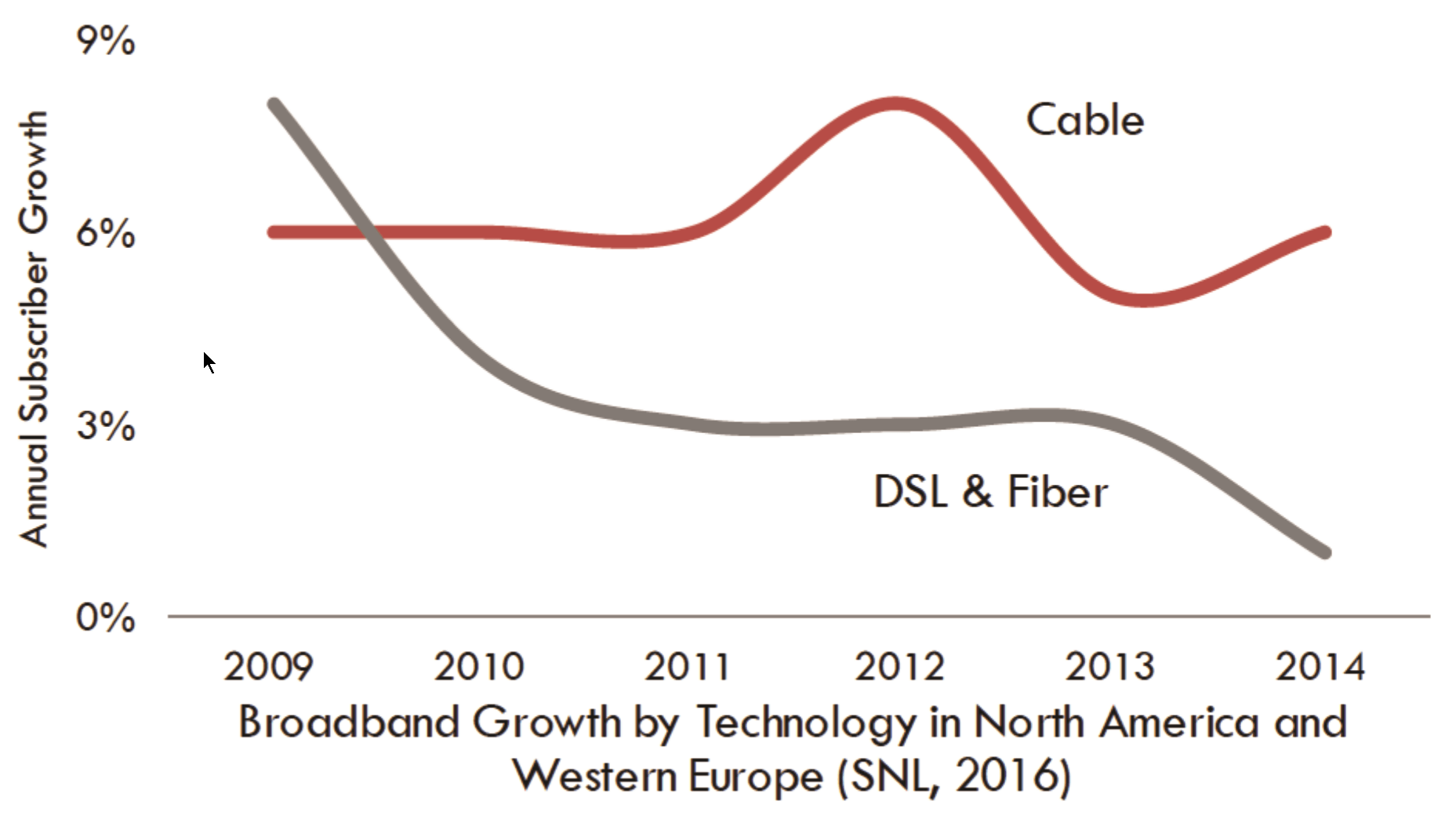
165 million
Forecasted cable broadband subscriptions in 2019. (Ovum)
Today in the US, cable serves an estimated 60% of all home broadband subscribers (though cable operators run their businesses independently and no single company serves more than 26% of total subscribers). Across all member nations of the Organization for Economic Co-operation and Development (OECD), cable accounts for 32% of all Internet subscriptions (including all fixed broadband technologies). Globally, DSL remains the most widely subscribed fixed Internet access technology.
Cable broadband has been deployed with private capital. Since 1996, US cable operators have invested $245 billion in their networks. And in the last eight years alone, cable operators in Europe have invested over $50 billion in capital.
Cable broadband subscribership will continue to grow. Ovum, a research firm, forecasts that global cable broadband subscriptions will rise from 137 million households in 2013 to 165 million in 2019.
Gigabit-Capable Cable
Cable broadband networks are critical to Internet access across the globe, and they are well suited to accommodate increasing Internet use. Current cable broadband technology is designed for speeds of a gigabit per second, which enable operators to deploy new services according to demand.
The cable network is composed of a hybrid of optical fiber and coaxial cable elements, and the specification that enables use of the network for broadband is known as Data Over Cable Service Interface Specification, or DOCSIS®, which was developed and continues to be advanced by CableLabs and its members with the input of vendor technology partners. The most widely deployed generation of DOCSIS technology, known as 3.0, is capable of providing a gigabit per second (Gbps) of broadband capacity, and is deployed nearly ubiquitously across cable networks in North America and Europe.
10 Gbps
Broadband performance offered by next-gen cable technology now in production.
The newest generation of DOCSIS broadband, known as 3.1, provides a near-term path toward continued improvement of cable broadband performance, with network capacity up to 10 gigabits per second. Equipment vendors are now supplying the necessary components. In January 2016, CableLabs certified the first DOCSIS 3.1 cable modems, and a number of operators have begun deploying the technology, including Cox, Comcast, Liberty Global, and others. In the US, cable customers in Atlanta and Nashville already have the option to subscribe to gigabit DOCSIS 3.1 broadband service through Comcast. IHS, a research firm, expects that by April 2017 a third of global cable subscribers will have access to DOCSIS 3.1 technology. Deployment of 3.1 at this rate represents acceleration over prior generations of the technology deployment, which has typically taken several years for widespread availability.
This continued evolution of cable broadband toward higher performance is possible largely over existing network infrastructure, with upgrades to software, electronics and some network components. Customer access to new services also requires use of the latest in-home technology. As part of the migration to new network technology, cable operators work to ensure that their customers have current Wi-Fi and modem equipment so that they can enjoy the full benefit of faster broadband services.
To realize the full potential of multi-gigabit cable technology, operators must consider alternative uses of their networks, which also carry television, voice, and other services. To do this, they monitor the growth of broadband demand on their networks and make adjustments to ensure adequate capacity by freeing capacity on the network for use. This can involve moving television service from analog to digital transmission, optimizing video delivery techniques such as compression, installing fiber deeper in the network, adding new electronics, or implementing a number of other techniques that improve efficiency and enable increased broadband capacity.
An operator’s assessment of these tradeoffs in light of specific market circumstances allows cable technology to provide a glide path toward multi-gigabit speeds. This model enables significant flexibility for operators to increase capacity as needed and in a manner that stays ahead of consumer demand. It also enables the benefits of gigabit broadband at lower cost and less construction-related local disruption than FTTP.
This ability to evolve cable broadband networks to meet growing demand is evident in the progression of cable technology and networks. Since the initial production of DOCSIS 1.0 devices in the late 1990s to the present day with DOCSIS 3.1 capability, cable technology has enabled significant growth of speed and performance.
| BROADBAND GENERATION | DOCSIS 1.0 | DOCSIS 1.1 | DOCSIS 2.0 | DOCSIS 3.0 | DOCSIS 3.1 |
|---|---|---|---|---|---|
| HIGHLIGHTS | Initial cable broadband technology | Added voice over IP service | Higher upstream speed | Greatly enhanced capacity | Capacity and efficiency progression |
| DOWNSTREAM CAPACITY | 40 Mbps | 40 Mbps | 40 Mbps | 1 Gbps | 10 Gbps |
| UPSTREAM CAPACITY | 10 Mbps | 10 Mbps | 30 Mbps | 100 Mbps | 1-2 Gbps |
| PRODUCTION DATE | 1997 | 2001 | 2002 | 2008 | 2016 |
As new technologies are specified by CableLabs and built by vendors, operators begin to deploy them. Over time, the clear trend has been a continuous increase in both the speeds offered in the market, which now reach one gigabit per second over cable broadband, and in the typical performance that consumers enjoy, which has grown by a factor of four over the four-year period for which data is available.
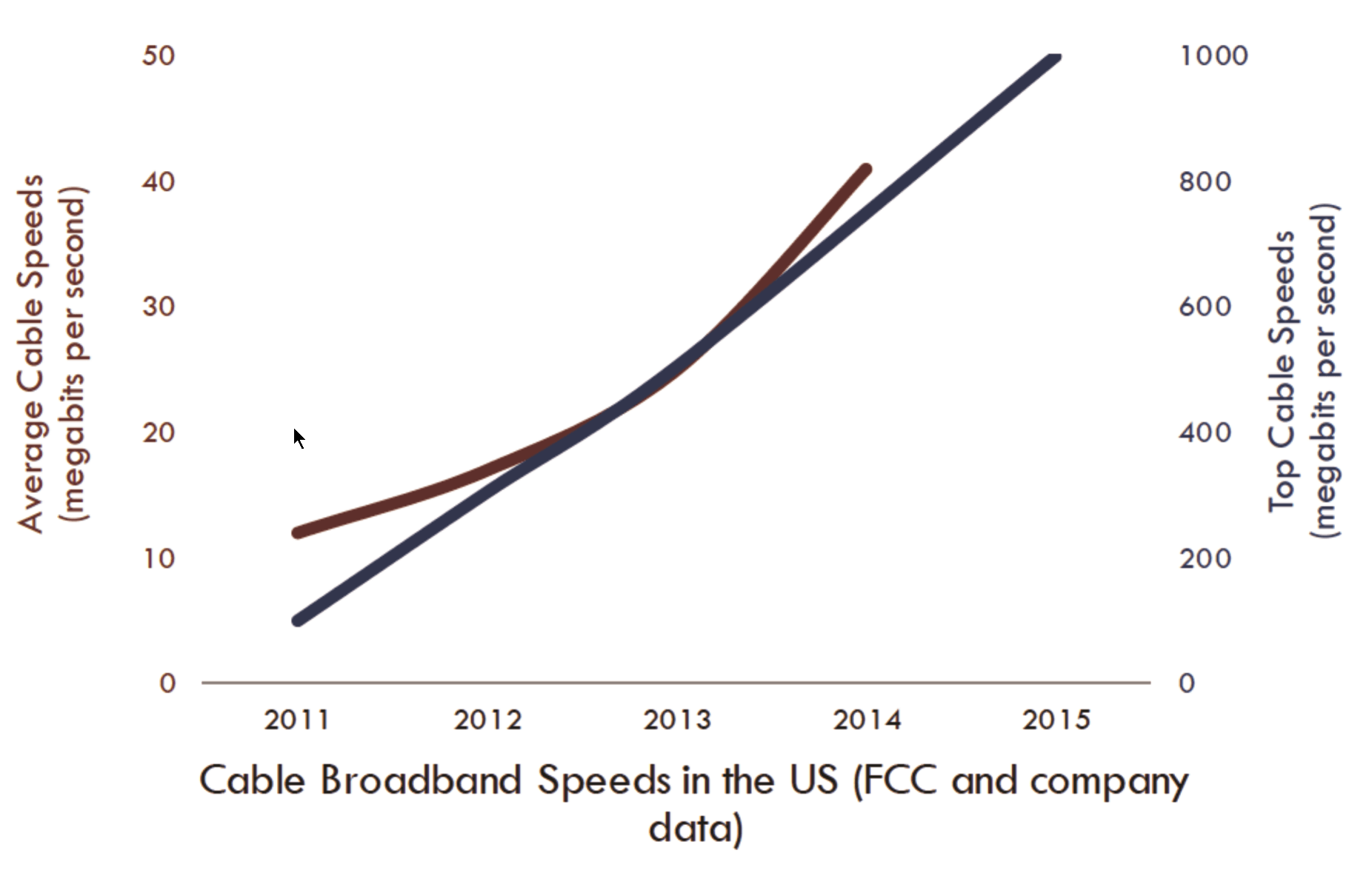
Going forward, as operators deploy DOCSIS 3.1 broadband, speeds will continue to grow.
Cable broadband technology therefore allows cable operators to stay ahead of consumer demand. Today, video streaming is the most common data-intensive application across the globe, requiring the most bandwidth of any type of broadband use.
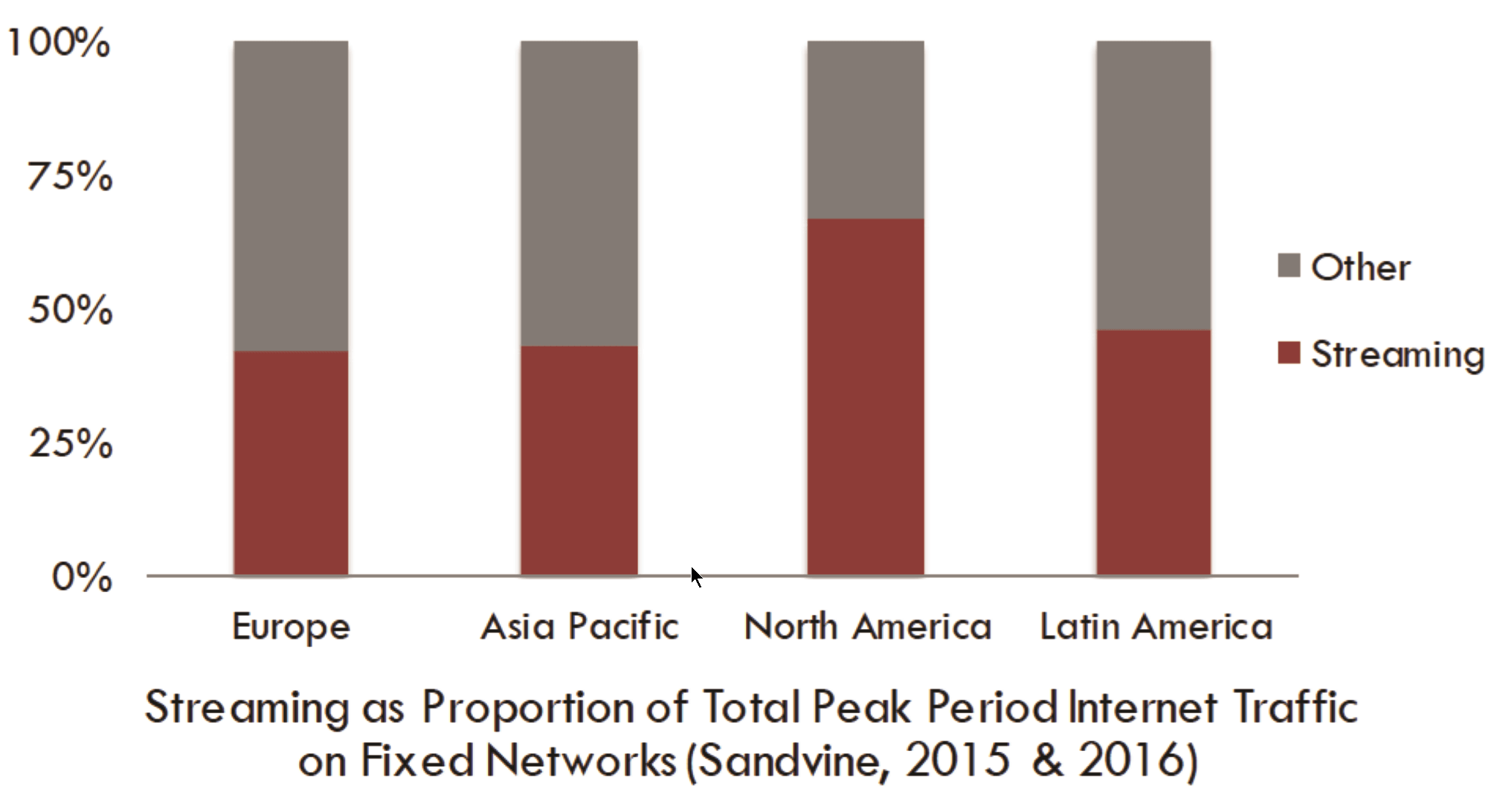
One of the most popular video streaming services, Netflix, reports its streaming rate as averaging less than 4 megabits per second. Typical cable subscribers enjoy speeds of more than 10 times this level, and gigabit speed is more than 250 times the amount required by this application. As video quality continues to improve with higher resolution and more dynamic color and brightness, video streaming is likely to require higher speeds. More intensive usage will likely arise from other applications and services as well.
As seen in the chart below, the applications and services most widely used by consumers require relatively small amounts of bandwidth compared with network capabilities. Applications that have the potential to be bandwidth-intensive tend not to be widely adopted today, despite broadband networks’ ability to meet their performance requirements.
For example, while consumers are beginning to adopt virtual reality, headsets now on the market generally require less than 100 Mbps capacity. More immersive video technologies, such as higher-resolution virtual reality or light field holographic displays, will require greater bandwidth, but are not widely adopted. Measured against the capabilities of broadband networks, including cable, it is evident that network technology is not a constraint on application innovation. To the contrary, network innovation appears to precede application innovation in terms of connectivity requirements.
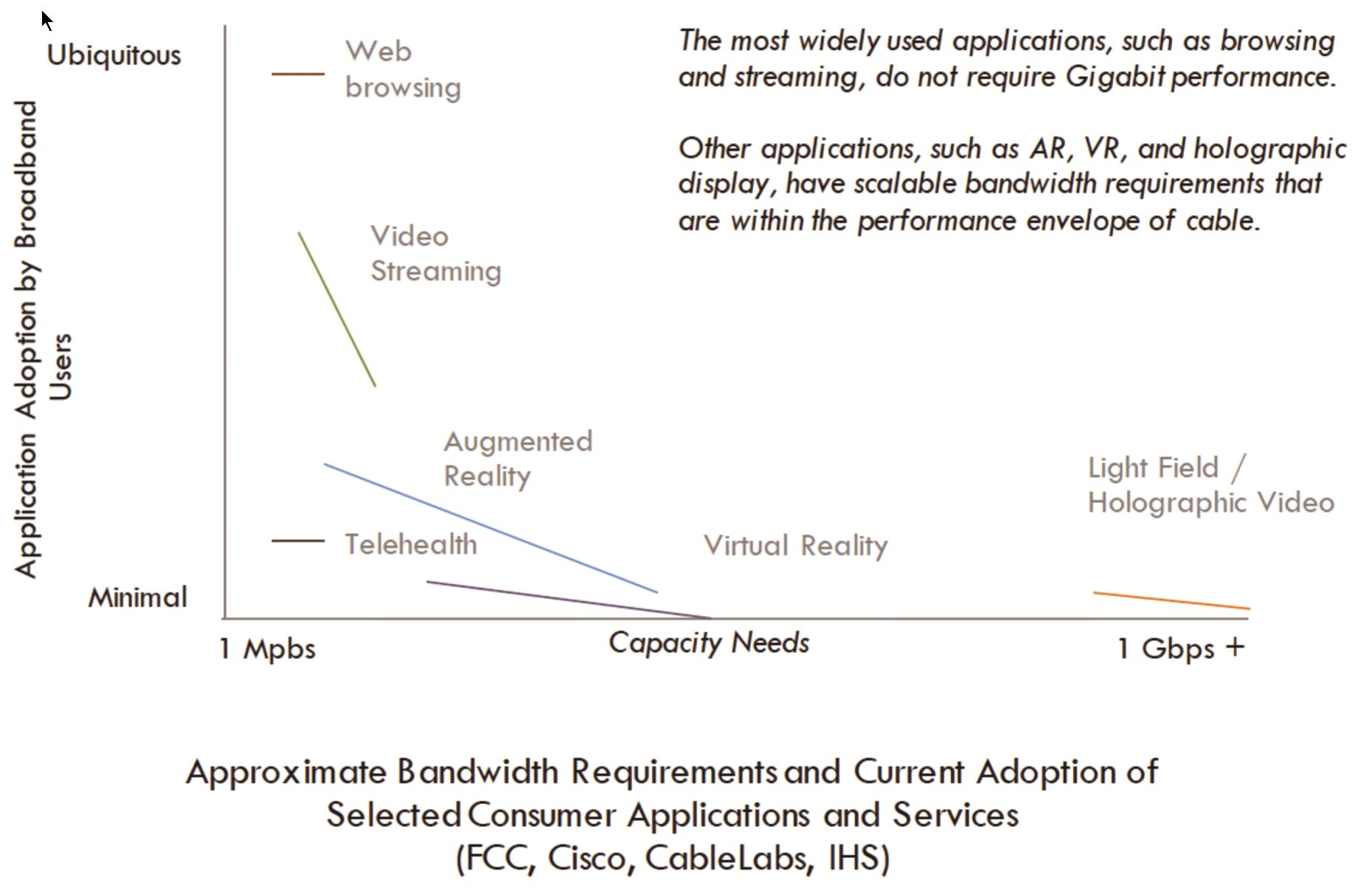
The growth of online applications and services complements the expansion of cable broadband network capabilities, and while this growth inherently leads to increased total network traffic, the likely impact to bandwidth needs – the amount of traffic that must be carried at any given moment – is less clear. Communications Chambers, a consultancy, forecasted that by 2023 the median UK household will require only 19 megabits per second, while the top 1% have demand of 35 megabits per second – far below the gigabit speeds that cable broadband can provide today. Furthermore, research conducted for OfCom suggests that consumer broadband quality of experience is not heavily influenced by speeds above 10 megabits per second.
While broadband speed is often the primary metric by which performance is judged, it is not the only factor that influences user experiences. Latency – the time between transmission and receipt – can also determine how users perceive broadband service. Cable broadband networks perform well in comparative measurement programs. The FCC’s Measuring Broadband America program, for instance, found that top-performing cable and FTTP networks have average round-trip latencies of about 15 milliseconds. The DOCSIS 3.1 specification requires networking equipment vendors to implement techniques that aid network responsiveness, which will further improve the cable broadband experience. Network latency is complex, influenced by many factors across the Internet, and is only one element alongside many others that can influence the quality of broadband user experiences. A more detailed discussion of latency and quality of experience is included as an appendix to this paper.
As judged against throughput, latency, and other dimensions, cable broadband is staying ahead of demand and enabling new applications. Emerging technologies and services such as augmented and virtual reality reinforce the value of broadband access. Adoption of new applications is not evenly distributed, but the capabilities of cable networks align the industry’s interest with continued online innovation.
The Next Generation of Broadband
Cable broadband network innovation is continuing. In February 2016, CableLabs announced a program to incubate a technology that will enable multi-gig symmetrical speeds, bringing upstream capacity of up to 6 gigabit per second and downstream capacity of up to 10 gigabit per second. Known as DOCSIS 4.0, this technology can, if proven to be successful, enable a new range of use cases that may require significantly more upstream traffic than is typical today.
Cable networks are today architected using frequency division duplex, meaning that bandwidth is divided on the network between upstream and downstream to prevent interference between traffic flowing in opposite directions. In general, much more bandwidth is allocated to the downstream usage, in the direction of the end user. That approach is consistent with current consumer broadband usage patterns. Video streaming, for instance, is largely a one-way application with most data traffic flowing downstream to the viewer. According to Sandvine, downstream traffic today makes up between 90 to 95 percent of all broadband data – on fixed networks of any type, including FTTP – during the busiest peak periods.
As the Internet continues to evolve, applications may take hold that require greater upstream bandwidth, including augmented reality, fully immersive video conferencing, and other interactive gigabit services. With DOCSIS 4.0 technology, CableLabs and its cable operator members are advancing capabilities to accommodate the continued evolution of broadband Internet access.
The global cable industry is researching and encouraging application innovations as gigabit networks continue to evolve. The Internet has fundamentally transformed communications and many aspects of society, and cable has played a significant role in facilitating its growth. Innovation in cable broadband technology will continue to enable the numerous benefits of Internet access.
Appendix A: DOCSIS 3.1 Technology Highlights
DOCSIS 3.1 is the latest cable broadband network technology. Specified by CableLabs in 2014, technology vendors are now producing compliant equipment and operators have begun to deploy the technology. DOCSIS 3.1 technology is backward-compatible with prior generations, enabling the flexibility for operators to deploy it over their footprint consistent with demand and other market factors.
DOCSIS 3.1 technology offers top-line potential capacity of 10 Gbps downstream and 1-2 Gbps upstream through a variety of mechanisms that make cable broadband more efficient and higher performing.
Architecture
DOCSIS 3.1 architecture is designed to enable the provision of broadband over hybrid fiber/coaxial cable networks. The frequency range enabled spans from 5 MHz to 1218 MHz. This provides 1.2 GHz of network bandwidth to offer 11 Gbps of total network capacity (combined downstream and upstream). In addition, DOCSIS 3.1 technology enables the flexibility to use up to 600 megahertz of additional bandwidth to drive total capacity even higher.
Upstream traffic uses the lower portion of the frequency duplex cable system, with an upper band edge configurable to between 42 and 204 MHz. Many North American cable systems today have an upper band edge of 42 MHz, while European systems use a 65 MHz upper band edge. Configuring the upstream band edge to 204 MHz fully enables the upstream gigabit capacity of DOCSIS 3.1 networks. Downstream traffic uses the upper portion of the duplex system, and a guard band is enabled to prevent interference between upstream and downstream traffic.
DOCSIS 3.1 channels span 192 MHz on the downstream and up to 96 MHz on the upstream. Orthogonal frequency division multiplexing (OFDM) is used with subcarriers as small as 25 kHz, which aids flexibility and resiliency of the network.
To increase capacity, channels can be aggregated across the full range of network bandwidth. However, services other than broadband, including television and voice, also utilize segmented capacity on cable networks today.
Efficiency
OFDM techniques of DOCSIS 3.1 technology enable more efficient operation of cable broadband by ensuring that small subcarriers on the network can independently make adjustments to their operation depending on the state of the channels in operation. Without OFDM, larger portions of bandwidth would be limited to the ‘lowest common denominator’ of what can be achieved in operational circumstances.
In addition, the technology utilizes low density parity check (LDPC) forward error correction as well as quadrature amplitude modulation (QAM) up to 16384 bits per symbol (with a minimum of 4096 QAM required by the specification) to enhance efficiency. Both represent significant advances in broadband communications technology, enabling the reliable provision of more data per unit of bandwidth. By comparison, 4096 QAM makes broadband networks two times more efficient on a bits per hertz basis relative to 64 QAM. LDPC enables higher performance to be realized more consistently than previous error correction techniques.
The DOCSIS 3.1 specification also enables increased energy efficiency, with cable modems entering ‘light sleep’ mode during periods of low utilization.
Security
The DOCSIS 3.1 specification requires that packets carrying subscriber traffic are capable of encryption using asymmetric and symmetric keying algorithms between the cable modem and the cable modem termination system. In addition, cable modems are authenticated using a public key infrastructure (PKI) digital signature. The cable PKI ecosystem is operated by CableLabs using a single root certificate. Security is reinforced with certification by CableLabs, which ensures that the security features of the specification are present. This approach to security has been a foundation of DOCSIS technology since its initial release, and encryption algorithms have continued to get stronger with reach new generation.
The specification also supports authenticating software image downloads used for updating the device. The technology does this through a digital signature process known as public key cryptography, which authenticates that software originates from trusted sources. This architecture applies to all DOCSIS 3.1 deployments, enabling secure broadband infrastructure on a global scale.
Responsiveness (Latency)
Though network capacity is often the first metric used to characterize broadband performance, latency, or the time between transmission and reception, also has bearing on user experiences. DOCSIS 3.1 technology uses advanced techniques to reduce latency on cable broadband networks.
The latency that a user experiences is influenced by a range of factors in the transmission of data across the Internet, many of which may be upstream of cable access networks. At every intermediate network node between packet origination and destination, routers, switches, and other network devices play a role in delivering data. Each node must assess data packets and make decisions about how they are to be forwarded. As data traffic bursts, network equipment may create a brief queue or ‘buffer’ before traffic is routed.
To enable network responsiveness and low latency even during periods of heavy traffic, DOCSIS 3.1 broadband employs an active queue management (AQM) technique that monitors the ‘buffer’ of traffic at cable modem termination systems and cable modems. This technique reduces latency by influencing the behavior of the Transmission Control Protocol (TCP) that underlies the Internet. By intelligently dropping data packets, AQM invokes TCP’s ability to balance throughput, latency, and packet loss based on the conditions of the links and networking devices along the path of data transmission. This approach improves user experiences by helping to significantly reduce latency during busy periods on the cable broadband segment of the network of networks that comprise the Internet. AQM was made available to DOCSIS 3.0 broadband systems, and is mandatory in the DOCSIS 3.1 specification.
DOCSIS 4.0 Technology
CableLabs and its members are currently developing an enhancement to DOCSIS 3.1 technology that will enable multi-gig symmetric capacity. Known as DOCSIS 4.0 technology, this development offers the ability to move beyond current frequency division architecture, instead using the full bandwidth available on cable networks for both upstream and downstream transmissions, simultaneously.
In the frequency division approach used today, a smaller proportion of bandwidth is allocated to upstream transmissions, constraining upstream performance relative to downstream. DOCSIS 4.0 technology would eliminate this limitation through simultaneous transmission of downstream and upstream traffic on the same frequencies at the same time. This is accomplished through intelligent transceiver design that enables interference cancellation by utilizing knowledge about transmission to subtract noise from signal. Since the transceiver knows what it is transmitting, DOCSIS 4.0 technology will use that information to process out noise and recover the intended received signal. DOCSIS 4.0 technology will provide substantial increases in total capacity over either time division duplex, which is used in DSL, or frequency division duplex, which is currently used in cable networks.
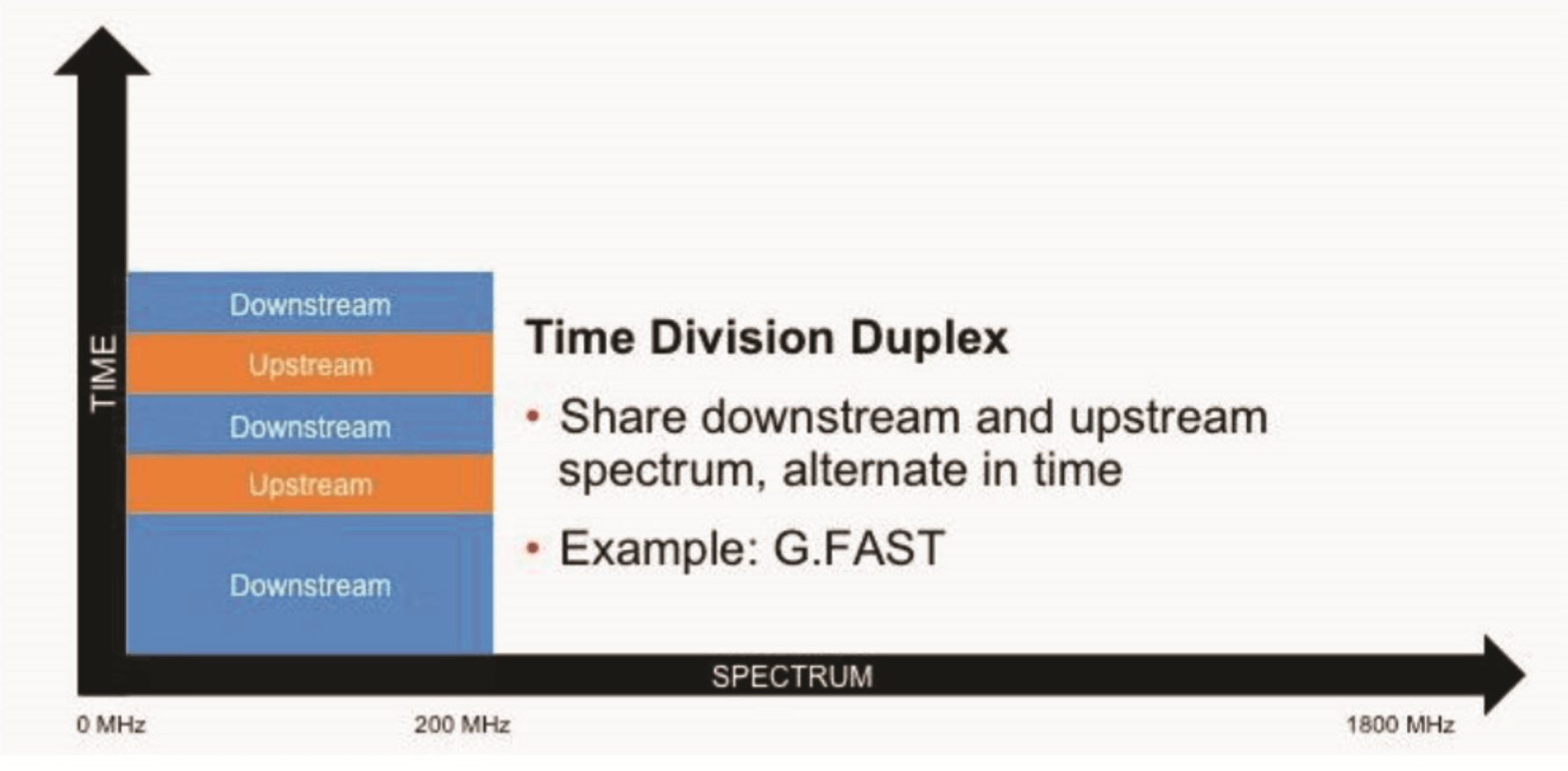 Time Division Duplex, used in DSL
Time Division Duplex, used in DSL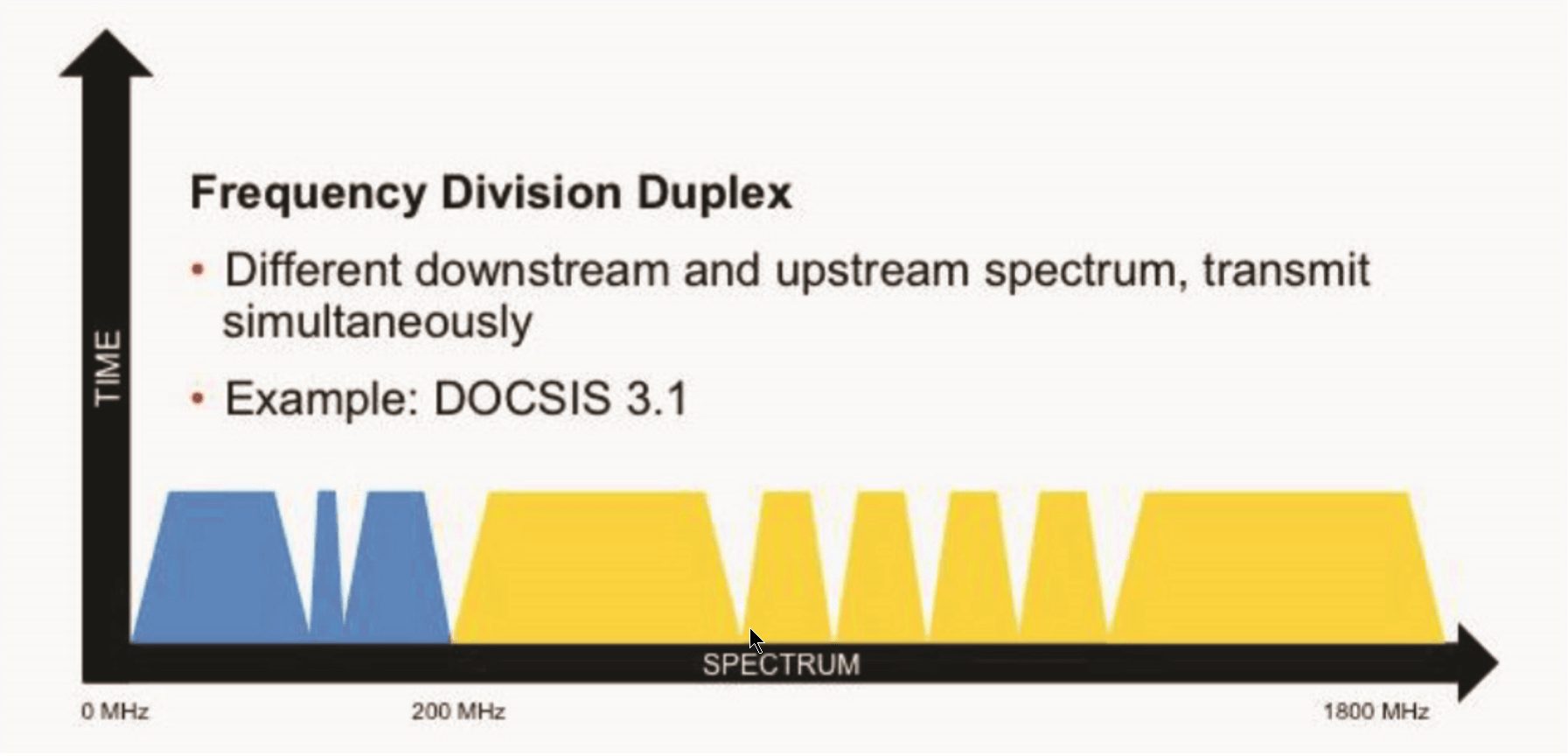 Frequency Division Duplex, used in current cable networks
Frequency Division Duplex, used in current cable networks
This capability is in development at CableLabs for possible future utilization. If ultimately implemented, DOCSIS 4.0 technology provides another evolution in cable broadband to enable continued performance gains.
Appendix B: Latency and Quality of Experience
Latency, the period between transmission and reception (or, request-response time), is influenced by a range of factors across the Internet, such as the physical distance that data must travel, the number of ‘hops’ across network nodes that data must traverse, and how networking equipment is configured, among other things. These factors can influence how responsive the Internet is perceived to be by users. For example, most web pages will not benefit from speeds in excess of 10 megabits per second, but if the total time between clicking and viewing a page can be reduced (i.e., by reducing round trip times for data, since web page loads typically involve a number of discrete content requests), the overall quality of experience is improved.
Latency is influenced by technical decisions made by many actors across the Internet. For instance, an application provider that caches content closer to its end users will improve the responsiveness of its service. There are several factors specific to the broadband access network that can influence latency as well, including the physics of the medium being used, the mechanism by which that medium is used to transmit data (medium access control), and the network architecture (physical topology) of the local network prior to its point of interconnection with the rest of the wider Internet.
The use of coaxial cable in access networks does not place cable broadband at any inherent latency disadvantage relative to other technologies, including fiber. In fact, the physics favor cable: The coaxial cable used by operators transmits energy at a slightly faster rate than what can be achieved over optical fiber. (Coaxial cable can transmit energy at approximately 83% the speed of light, while optical fiber can transmit energy at approximately 65% the speed of light.) However, since cable networks are becoming ever more fiber-rich, and the distance that data traverses coaxial network elements continues to decrease, there is little practical effect of this distinction in physics.
Medium access control protocols are necessary in both cable and FTTP networks, since both entail sharing network resources across users. Accordingly, user data is scheduled on the network in both technologies, which occurs in near real-time. This MAC scheduling does introduce some latency, with the specific impact dependent on the protocol and the number of connected endpoints. With respect to local network architecture, differences do exist from network to network, but these do not vary strictly as a function of technology.
Therefore, cable and FTTP networks are technologically equivalent as pertains to latency, and differences between networks are more likely to be driven by factors that are not reliant on the choice of physical medium. Latency parity potential between cable and FTTP is seen, for example, in the FCC’s Measuring Broadband America program. The top-performing cable and FTTP networks average round-trip latencies of about 15 milliseconds. The DOCSIS 3.1 specification requires networking equipment vendors to implement techniques that aid network responsiveness, which will further improve the cable broadband experience.
It is important to keep in mind that, in general, access network physics are not a major contributor to latency, nor are they a critical enabler of responsiveness. Physical distances, number of network hops, routing protocols, and networking equipment are generally more significant factors. Reducing latency beyond the performance that is typical today on cable and FTTP will therefore involve broader system and application architecture decisions – which may or may not be an appropriate variable to optimize for, given the diverse needs of applications that utilize the Internet. Many widely used applications are latency-tolerant; for example, video streaming generally entails pre-loading content, which means that capacity is important but user experiences can be quite good even if latency is high. Others, such as video calling, require greater interactivity in real-time, and the ability to improve responsiveness is limited by physics when call participants are geographically dispersed.
Applications that would benefit from extremely low latencies require end-to-end architectures that are purpose-built. In such cases, meeting these requirements means not only moving the application server closer to end users, but also ensuring that compute and processing capabilities in user devices are capable. For the millisecond latency applications often discussed in the context of 5G, for instance, the access network link may still play a crucial role in delivering the service, but that role is likely to entail delivering content before it is to be viewed, with local resources responsible for rendering them useful.
These observations make clear that latency is an important component of gauging the quality of experience for broadband users, but it is insufficient on its own. Indeed, any single metric, construed narrowly to any single Internet actor, inevitably casts a simplistic picture of broadband performance. To truly understand quality of experience, one must understand the attributes of the diverse range of activities that occur on the Internet, the metrics against which they are best judged, and all of the inputs across the Internet ecosystem – from application server to user interface, and everything in between – that influence those metrics.
Quality of experience in broadband is an emerging and important field of research, reflecting the still-nascent nature of the Internet. Going forward, as users increasingly demand connectivity and services that are fit for their intended uses and purposes, appropriately characterizing broadband performance will be central to fostering the continued growth of the Internet.
Endnotes
- Actual Experience, “Measurement of Internet Quality of Service”, a report for OfCom, November 2015.
- Center for Technology, Innovation and Competition at the University of Pennsylvania Law School, “US vs. European Broadband Deployment: What Do the Data Say?”, June 2014.
- Cisco, “Visual Networking Index: Forecast and Methodology, 2015-2020”, June 2016.
- Communications Chambers, “Domestic demand for bandwidth: An approach to forecasting requirements for the period 2013-2023”, report to the UK Broadband Stakeholder Group, November 2013.
- comScore, “Cross-Platform Future in Focus”, 2016.
- Federal Communications Commission, “Broadband Speed Guide”.
- Federal Communications Commission, “Measuring Broadband America: Fixed Broadband Report”, 2015.
- IHS Technology, “Broadband Coverage in Europe 2015”, April 2016.
- IHS, “Biggest Trend among Cable Operators: Massive DOCSIS Deployments and a Shift to Remote/Distributed Access”, July 2015.
- IHS, “World Market for Telehealth”, January 2014.
- Infonetics Research, “Service Provider Capex, Opex, Revenue, and Subscribers Database”, 2Q 2015.
- Infonetics Research, “Fixed Broadband Subscribers Report”, 2015.
- International Telecommunications Union, “The Impact of Broadband on the Economy: Research to Date and Policy Issues”, April 2012.
- International Telecommunications Union, “Requirements for low-latency interactive multimedia streaming”, Rec-F.746.1, October 2014.
- Internet Live Stats, “Internet Users”, accessed July 2016.
- Leichtman Research Group, “Research Notes”, 2Q2016.
- MacArthur Foundation, “Does the Internet Make for More Engaged Citizens?”, February 2011.
- McKinsey Global Institute, “The great transformer: The impact of the Internet on economic growth and prosperity”, October 2011.
- OECD Broadband Database, accessed July 2016.
- OfCom, “Adults’ media use and attitudes”, 2015 Report.
- Ovum, “Telecoms, Media, & Entertainment Outlook 2015”.
- Sandvine, “Global Internet Phenomena”, 2015 and 2016.
- SNL, “Multichannel Market Trends”, May 2016.
- SNL, “Global top 30 fixed-broadband providers”, 2016.
- Wi-Fi Alliance, “New research: Wi-Fi is more important than ever”, December 2015.
About Cablelabs
As the leading innovation and R&D lab for the cable industry, CableLabs creates global impact through its member companies around the world and its subsidiaries, Kyrio and UpRamp. With a state-of-the art research and innovation facility and collaborative ecosystem with thousands of vendors, CableLabs delivers impactful network technologies for the entire industry.
About Informed Insights
CableLabs created the Inform[ED] Insights series to periodically address major technology developments that have the potential to transform the cable business and society at large.
The cable industry connects and entertains people across the globe, contributing significantly to economic growth and enabling rich discourse in our countries of operation. Inform[ED] Insights will provide leaders across sectors and disciplines with communications technology facts and insights on which to base decisions of significance.







